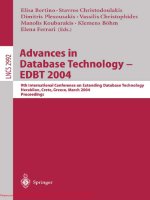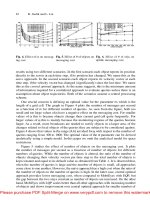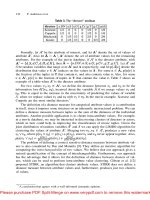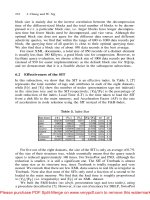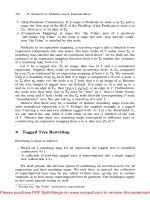Tài liệu Advances in Database Technology- P8 docx
Bạn đang xem bản rút gọn của tài liệu. Xem và tải ngay bản đầy đủ của tài liệu tại đây (1.3 MB, 50 trang )
332
S.
Skiadopoulos et al.
Fig. 1. Reference tiles and relations
is in REG*. Notice that region is disconnected and has a hole.
Let us now consider two arbitrary regions and in REG*. Let region be
related to region through a cardinal direction relation (e.g., is north of
Region will be called the reference region (i.e., the region which the relation
refers to) while region will be called the primary region (i.e., the region for
which the relation is introduced). The axes forming the minimum bounding box
of the reference region divide the space into 9 areas which we call tiles (Fig. 1a).
The peripheral tiles correspond to the eight cardinal direction relations south,
southwest, west, northwest, north, northeast, east and southeast. These tiles
will be denoted by and
respectively. The central area corresponds to the region’s minimum bounding
box and is denoted by By definition each one of these tiles includes the
parts of the axes forming it. The union of all 9 tiles is
If a primary region is included (in the set-theoretic sense) in tile of
some reference region (Fig. 1b) then we say that is south of and we write
Similarly, we can define southwest (SW), west (W), northwest (NW),
north (N), northeast (NE), east (E), southeast (SE) and bounding box (B)
relations. If a primary region lies partly in the area and partly in
the area of some reference region (
Fig. 1c) then we say that
is partly
northeast and partly east of and we write N E:E
The general definition of a cardinal direction relation in our framework is as
follows.
Definition 1. A cardinal direction relation is an expression where
(a)
and
(c) for every such that 1 and A cardinal direction
relation
is called single-tile if
otherwise it is called multi-tile.
Let and be two regions in REG*. Single-tile cardinal direction relations
are defined as follows:
S
In Fig. 1, regions and are in REG (also in REG*) and region
Please purchase PDF Split-Merge on www.verypdf.com to remove this watermark.
Computing and Handling Cardinal Direction Information
333
In Definition 1 notice that for every such that 1 and
and have disjoint interiors but may share points in their boundaries.
Example 1. S, N E:E and B:S:SW:W:NW:N:E:SE are cardinal direction re-
lations. The first relation is single-tile while the others are multi-tile. In Fig. 1,
we have SNE:E and
B:S:SW:W:NW:N:E:SE
For instance in Fig.
1d, we have
because there exist regions
in REG* such that
and
In order to avoid confusion, we will write the single-tile elements of a cardinal
direction relation according to the following order: B, S, SW, W, NW, N, NE,
E and SE. Thus, we always write B:S:W instead of W:B:S or S:B:W. Moreover,
for a relation such as B:S:W we will often refer to B, S and W as its tiles.
The set of cardinal direction relations for regions in REG* is denoted by
Relations in are jointly exhaustive and pairwise disjoint, and can be used to
represent definite information about cardinal directions, e.g., N Using the
relations of as our basis, we can define the powerset of which contains
relations. Elements of are called disjunctive cardinal direction relations
and can be used to represent not only definite but also indefinite information
about cardinal directions, e.g., { N, W} denotes that region is north or west
of region
Notice that the inverse of a cardinal direction relation R, denoted by inv(R),
is not always a cardinal direction relation but, in general, it is a disjunctive cardi-
nal direction relation. For instance, if S then it is possible that
N E:N:NW
regions and is fully characterized by the pair where and
are cardinal directions such that (a) (b) (c) is a disjunct
of inv and (d) is a disjunct of An algorithm for computing
the inverse relation is discussed in [21]. Moreover, algorithms that calculate the
composition of two cardinal direction relations and the consistency of a set of
cardinal direction constraints are discussed in [20,21,22].
Goyal and Egenhofer [5,6] use direction relation matrices to represent cardi-
nal direction relations. Given a cardinal direction relation the
In general, each multi-tile relation is defined as follows:
B
:
S
:
SW
:
W
:
NW
:
N
:
SE
:
E
or N E:S or N:NW or N Specifically, the relative position of two
Please purchase PDF Split-Merge on www.verypdf.com to remove this watermark.
334
S.
Skiadopoulos et al.
Fig. 2. Using polygons to represent regions
cardinal direction relation matrix that corresponds to R is a 3×3 matrix defined
as follows:
For instance, the direction relation matrices that correspond to relations S,
N E:E and B:S:SW:W:NW:N:E:SE of Example 1 are as follows:
At a finer level of granularity, the model of [5,6] also offers the option to
record how much of the a region falls into each tile. Such relations are called
cardinal direction relations with percentages and can be represented with cardinal
direction matrices with percentages. Let and be two regions in REG*. The
cardinal direction matrices with percentages can be defined as follows:
where denotes the area of region
Consider for example regions and in Fig. 1c; region is 50% northeast
and 50% east of region This relation is captured with the following cardinal
direction matrix with percentages.
In this paper, we will use simple assertions (e.g., S, B:S:SW) to capture
cardinal direction relations [20,21] and direction relations matrices to capture
cardinal direction relations with percentages [5,6].
Please purchase PDF Split-Merge on www.verypdf.com to remove this watermark.
Computing and Handling Cardinal Direction Information
335
Fig. 3. Polygon clipping
3
Computing Cardinal Direction Relations
Typically, in Geographical Information Systems and Spatial Databases, the con-
nected regions in REG are represented using single polygons, while the com-
posite regions in REG* are represented using sets of polygons [18,23]. In this
paper, the edges of polygons are taken in a clockwise order. For instance, in
Fig. 2 region is represented using polygon and re-
gion is represented using polygons and
Notice than using sets of polygons, we can even represent re-
gions with holes. For instance, in Fig. 2 region is represented using
polygons and
Given the polygon representations of a primary region and a reference
region the computation of cardinal direction relations problem lies in the cal-
culation of the cardinal direction relation R, such that R holds. Similarly,
we can define the computation of cardinal direction relations with percentages
problem.
Let us consider a primary region and a reference region According to
Definition 1, in order to calculate the cardinal direction relation between region
and we have to divide the primary region into segments such that each
segment falls exactly into one tile of Furthermore, in order to calculate the
cardinal direction relation with percentages we also have to measure the area of
each segment. Segmenting polygons using bounded boxes is a well-studied topic
of Computational Geometry called polygon clipping [7,10]. A polygon clipping
algorithm can be extended to handle unbounded boxes (such as the tiles of refer-
ence region as well. Since polygon clipping algorithms are very efficient (linear
in the number of polygon edges), someone would be tempted to use them for the
calculation of cardinal direction relations and cardinal direction relations with
percentages. Let us briefly discuss the disadvantages of such an approach.
Let us consider regions and presented in Fig. 3a. Region is formed
by a quadrangle (i.e., a total of 4 edges). To achieve the desired segmentation,
polygon clipping algorithms introduce to new edges [7,10]. After the clipping
algorithms are performed (Fig. 3b), region is formed by 4 quadrangles (i.e.,
a total of 16 edges). The worst case that we can think (illustrated in Fig. 3c)
starts with 3 edges (a triangle) and ends with 35 edges (2 triangles, 6 quadrangles
and 1 pentagon). These new edges are only used for the calculation of cardinal
direction relations and are discarded afterwards. Thus, it would be important
Please purchase PDF Split-Merge on www.verypdf.com to remove this watermark.
336
S. Skiadopoulos et al.
to minimize their number. Moreover, in order to perform the clipping the edges
of the primary region must be scanned 9 times (one time for every tile of
the reference region In real GIS applications, we expect that the average
number of edges is high. Thus, each scan of the edges of a polygon can be quite
time consuming. Finally, polygon clipping algorithms sometimes require complex
floating point operations which are costly.
In Sections 3.1 and 3.2, we consider the problem of calculating cardinal direc-
tion relations and cardinal direction relations with percentages respectively. We
provide algorithms specifically tailored for this task, which avoid the drawbacks
of polygon clipping methods. Our proposal does not segment polygons; instead
it only divides some of the polygon edges. In Example 2, we show that such a
division is necessary for the correct calculation. Interestingly, the resulting num-
ber of introduced edges is significantly smaller than the respective number of
polygon clipping methods. Furthermore, the complexity of our algorithms is not
only linear in the number of polygon edges but it can be performed with a single
pass. Finally, our algorithms use simple arithmetic operations and comparisons.
3.1
Cardinal Direction Relations
We will start by considering the calculation of cardinal constraints relations
problem. First, we need the following definition.
Definition 2. Let be basic cardinal direction relations. The tile-
union of denoted by tile-union is a relation formed
from the union of the tiles of
For instance, if and then we have
tile-union and tile-union
Let and be sets of polygons representing
a primary region and a reference region To calculate the cardinal direction
R between the primary region and the reference region we first record the
tiles of region where the points forming the edges of the polygons
fall in. Unfortunately, as the following example presents, this is not enough.
Example 2. Let us consider the region (formed by the single polygon
and the region presented in Fig. 4a. Clearly points and
lie in and respectively, but the relation between
and is B:W:NW:N:NE and not W:NW:NE.
The problem of Example 2 arises because there exist edges of polygon
that expand over three tiles of the reference region For instance,
expands over tiles and In order to handle such situations,
we use the lines forming the minimum bounding box of the reference region to
divide the edges of the polygons representing the primary region and create
new edges such that (a) region does not change and (b) every new edge lies in
exactly one tile. To this end, for every edge AB of region we compute the set of
intersection points of AB with the lines forming box We use the intersection
Please purchase PDF Split-Merge on www.verypdf.com to remove this watermark.
Computing and Handling Cardinal Direction Information
337
Fig. 4. Illustration of Examples 2 and 3
points of to divide AB into a number of segments Each
segment lies in exactly one tile of and the union of all tiles is
AB. Thus, we can safely replace edge AB with without affecting
region Finally, to compute the cardinal direction between regions and we
only have to record the tile of where each new segment lies. Choosing a single
point from each segment is sufficient for this purpose; we choose to pick the
middle of the segment as a representative point. Thus, the tile where the middle
point lies gives us the tile of the segment too. The above procedure is captured in
Algorithm C
OMPUTE-CDR (Fig. 5) and is illustrated in the following example.
Example 3. Let us continue with the regions of Example 2 (see also Fig. 4). Algo-
rithm C
OMPUTE
-CDR considers every edge of region
(polygon
in turn and performs the replacements presented in the following table.
It easy to verify that every new edge lies in exactly one tile of (Fig. 4b).
The middle points of the new edges lie in and
Therefore, Algorithm COMPUTE-CDR returns B:W:NW:N:NE:E, which
precisely captures the cardinal direction relation between regions and
Notice that in Example 3, Algorithm COMPUTE-CDR takes as input a quad-
rangle (4 edges) and returns 9 edges. This should be contrasted with the polygon
clipping method that would have resulted in 19 edges (2 triangles, 2 quadrangles
and 1 pentagon). Similarly, for the shapes in Fig. 3b-c, Algorithm COMPUTE-
CDR introduces 8 and 11 edges respectively while polygon clipping methods
introduce 16 and 34 edges respectively.
The following theorem captures the correctness of Algorithm COMPUTE-
CDR and measures its complexity.
Theorem 1. Algorithm COMPUTE-CDR is correct, i.e., it returns the cardinal
direction relation between two regions and in REG* that are represented
using two sets of polygons and respectively. The running time of Algorithm
Please purchase PDF Split-Merge on www.verypdf.com to remove this watermark.
338
S. Skiadopoulos et al.
Fig. 5. Algorithm COMPUTE-CDR
C
OMPUTE
-CDR is where (respectively is the total number of
edges of all polygons in (respectively
Summarizing this section, we can use Algorithm COMPUTE-CDR to compute
the cardinal direction relation between two sets of polygons representing two
regions and in REG*. The following section considers the case of cardinal
direction relations with percentages.
3.2
Cardinal Direction Relations with Percentages
In order to compute cardinal direction relations with percentages, we have to
calculate the area of the primary region that falls in each tile of the reference
region. A naive way for this task is to segment the polygons that form the primary
region so that every polygon lies in exactly one tile of the reference region. Then,
for each tile of the reference region we find the polygons of the primary region
that lie inside it and compute their area. In this section, we will propose an
alternative method that is based on Algorithm C
OMPUTE-CDR. This method
simply computes the area between the edges of the polygons that represent
the primary region and an appropriate reference line without segmenting these
polygons.
We will now present a method to compute the area between a line and an
edge. Then, we will see how we can extend this method to compute the area of
a polygon. We will first need the following definition.
Definition 3. Let AB be an edge and be a line. We say that does not cross
AB if and only if one of the following holds: (a) AB and do not intersect, (b)
AB and intersect only at point A or B, or (c) AB completely lies on
Please purchase PDF Split-Merge on www.verypdf.com to remove this watermark.
Computing and Handling Cardinal Direction Information
339
Fig. 6. Lines not crossing AB
Fig. 7. Area between an edge and a line
For example, in Fig. 6 lines and do not cross edge AB. Let us now
calculate the area between an edge and a line.
Definition 4. Let and be two points forming edge
and be two lines that do not cross AB. Let also and (respectively
– see also Fig. 7. We define expression and as follows:
Expressions and can be positive or negative depending on
holds. The absolute value of equals to the area
between edge AB and line i.e., the area of polygon In other
words, the following formula holds.
Symmetrically, area between edge AB and line i.e., the area of polygon
equals to the absolute value of
Expressions and can be used to calculate the
area of polygons. Let
be a polygon, and
be two lines that do not cross
with any edge of polygon The area of polygon denoted by can be
calculated as follows:
Notice that Computational Geometry algorithms, in order to calculate the
area of a polygon use a similar method that is based on a reference point
and be the projections of points A,B to line (respectively
the direction of vector
It is easy to verify that
and
Please purchase PDF Split-Merge on www.verypdf.com to remove this watermark.
340
S. Skiadopoulos et al.
Fig. 8. Using expression to calculate the area of a polygon
(instead of a line) [12,16]. This method is not appropriate for our case because
it requires to segment the primary region using polygon clipping algorithms (see
also the discussion at the beginning of Section 3). In the rest of this section, we
will present a method that utilizes expressions and and does not require
polygon clipping.
Example 4. Let us consider polygon and line pre-
sented in Fig. 8d. The area of polygon can be calculated using formula
All the intermediate
expressions
are presented as the gray areas
of Fig. 8a-d respectively.
We will use expressions and to compute the percentage of the area of
the primary region that falls in each tile of the reference region. Let us consider
region presented Fig. 9. Region is formed by polygons and
Similarly to Algorithm COMPUTE-CDR, to compute the cardinal
direction relation with percentages of with we first use the to divide
the edges of region Let and be the lines forming
These lines divide the edges of polygons and
as shown in Fig. 9.
Let us now compute the area of that lies in the NW tile of (i.e.,
Notice that area To com-
pute the area of polygon it is convenient to use as a reference line
Please purchase PDF Split-Merge on www.verypdf.com to remove this watermark.
Computing and Handling Cardinal Direction Information
341
Fig. 9
.
Computing cardinal direction relations with percentages
Doing so, we do not have to compute edges and because
and hold and thus the area we are looking for
can be calculated with the following formula:
In other words, to compute the area of that lies in
we calculate the area between the west line of and every
edge of that lies in i.e., the following formula holds:
Similarly, to calculate the area of that lies in the and we can
use the expressions:
For instance, in Fig. 9 we have
and
To calculate the area of that lies in and we
simply have to change the line of reference that we use. In the first three cases,
we use the east line of (i.e., in Fig. 9), in the fourth case, we use
the south line of and in the last case, we use the north line of
In all cases, we use the edges of that fall in the tile of that
we are interested in. Thus, have:
For instance, in Fig. 9 we have
and
Please purchase PDF Split-Merge on www.verypdf.com to remove this watermark.
342
S. Skiadopoulos et al.
Let us now consider the area of that lies in None of the lines of
can help us compute without segmenting the polygons
that represent region For instance, in Fig. 9 using line we have:
Edge is not an edge of any of the polygons representing To handle such
situations, we employ the following method. We use the south line of
as the reference line and calculate the areas between and all edges
that lie both in and This area will be denoted by
and is practically the area of that lies on and i.e.,
Since has been previously
computed, we just have to subtract it from in order to
derive For instance, in Fig. 9 we have:
and
Therefore, holds.
The above described method is summarized in Algorithm COMPUTE-CDR-CDR%
presented in Fig. 10. The following theorem captures the correctness of Algo-
rithm C
OMPUTE-CDR% and measures its complexity.
Theorem 2. Algorithm COMPUTE-CDR% is correct, i.e., it returns the cardi-
nal direction relation with percentages between two regions and in REG* that
are represented using two sets of polygons and respectively. The running
time of Algorithm COMPUTE-CDR% is where (respectively is
the total number of edges of all polygons in (respectively
In the following section, we will present an actual system, CARDIRECT,
that incorporates and implements Algorithms COMPUTE-CDR and COMPUTE-
CDR%.
4
A Tool for the Manipulation of Cardinal Direction
Information
In this section, we will present a tool that implements the aforementioned reason-
ing tasks for the computation of cardinal direction relationships among regions.
The tool, CARDIRECT, has been implemented in C++ over the Microsoft Vi-
sual Studio toolkit. Using CARDIRECT, the user can define regions of interest
over some underlying image (e.g., a map), compute their relationships (with and
Please purchase PDF Split-Merge on www.verypdf.com to remove this watermark.
Computing and Handling Cardinal Direction Information
343
Fig. 10. Algorithm COMPUTE-CDR%
without percentages) and pose queries. The tool implements an XML interface,
through which the user can import and export the configuration he constructs
(i.e., the underlying image and the sets of polygons that form the regions); the
XML description of the configuration is also employed for querying purposes.
The XML description of the exported scenarios is quite simple: A configura-
tion (
Image
) is defined upon an image file (e.g., a map) and comprises a set of
regions and a set of relations among them. Each region comprises a set of poly-
gons of the same color and each polygon comprises a set of edges (defined by
and The direction relations among the different regions are all
stored in the XML description of the configuration. The DTD for CARDIRECT
configurations is as follows.
Please purchase PDF Split-Merge on www.verypdf.com to remove this watermark.
344
S. Skiadopoulos et al.
Fig. 11. Using C
AR
D
IRECT
to annotate images
Observe Fig. 11. In this configuration, the user has opened a map of Ancient
Greece at the time of the Peloponnesian war as the underlying image. Then, the
user defined three sets of regions: the “Athenean Alliance” in blue, comprising
of Attica, the Islands, the regions in the East, Corfu and South Italy; (b) the
“Spartan Alliance” in red, comprising of Peloponnesos, Beotia, Crete and Sicely;
and (c) the “Pro-Spartan” in black, comprising of Macedonia.
Moreover, using C
ARDIRECT, the user can compute the cardinal direction
relations and the cardinal direction relations with percentages between the iden-
tified regions. In Fig. 12, we have calculated the relations between the regions
of Fig. 11. For instance, Peloponnesos is B:S:SW:W of Attica (left side of Fig.
12) while Attica is
of Peloponnesos (right-hand side of Fig. 12).
The query language that we employ is based on the following simple model.
Let be a set of regions in REG* over a configuration. Let C
be a finite set of thematic attributes for the regions of REG* (e.g., the color of
each region) and a function, practically relating each of
the regions with a value over the domain of C (e.g., the fact that the Spartan
Alliance is colored red).
A query condition over variables is a conjunction the following
types of formulae where is a
Please purchase PDF Split-Merge on www.verypdf.com to remove this watermark.
Computing and Handling Cardinal Direction Information
345
Fig. 12.
Using CARDIRECT to extract cardinal direction relations
region of the configuration, is a value of a thematic attribute and
is a (possibly disjunctive) cardinal direction relation. A query over
variables is a formula of the form
where is a query condition.
Intuitively, the query returns a set of regions in the configuration of an image
that satisfy the query condition, which can take the form of: (a) a cardinal
direction constraint between the query variables (e.g., B:SE:S (b) a
restriction in the thematic attributes of a variable (e.g., and
(c) direct reference of a particular region (e.g.,
For instance, for the configuration of Fig. 11 we can pose the following query:
“Find all regions of the Athenean Alliance which are surrounded by a region in
the Spartan Alliance”. This query can be expressed as follows:
5
Conclusions and Future Work
In this paper, we have addressed the problem of efficiently computing the car-
dinal direction relations between regions that are composed of sets of polygons
(a) by presenting two linear algorithms for this task, and (b) by explaining
their incorporation into an actual system. These algorithms take as inputs two
sets of polygons representing two regions respectively. The first of the proposed
algorithms is purely qualitative and computes the cardinal direction relations
between the input regions. The second has a quantitative aspect and computes
the cardinal direction relations with percentages between the input regions. To
the best of our knowledge, these are the first algorithms that address the afore-
mentioned problem. The algorithms have been implemented and embedded in
an actual system, C
ARDIRECT, which allows the user to specify, edit and anno-
tate
regions
of
interest
in an
image. Then,
C
AR
D
IRECT
automatically computes
Please purchase PDF Split-Merge on www.verypdf.com to remove this watermark.
346
S. Skiadopoulos et al.
the cardinal direction relations between these regions. The configuration of the
image and the introduced regions is persistently stored using a simple XML de-
scription. The user is allowed to query the stored XML description of the image
and retrieve combinations of interesting regions on the basis of the query.
Although this part of our research addresses the problem of relation compu-
tation to a sufficient extent, there are still open issues for future research. First,
we would like to evaluate experimentally our algorithm against polygon clipping
methods. A second interesting topic is the possibility of combining topological
[2] and distance relations [3]. Another issue is the possibility of combining the
underlying model with extra thematic information and the enrichment of the
employed query language on the basis of this combination. Finally, a long term
goal would be the integration of C
ARDIRECT with image segmentation software,
which would provide a complete environment for the management of image con-
figurations.
References
1.
2.
3.
4.
5.
6.
7.
8.
9.
E. Clementini, P. Di Fellice, and G. Califano. Composite Regions in Topological
Queries. Information Systems, 7:759–594, 1995.
M.J. Egenhofer. Reasoning about Binary Topological Relationships. In Proceedings
of SSD’91, pages 143–160, 1991.
A.U. Frank. Qualitative Spatial Reasoning about Distances and Directions in
Geographic Space. Journal of Visual Languages and Computing, 3:343–371, 1992.
A.U. Frank. Qualitative Spatial Reasoning: Cardinal Directions as an Example.
International Journal of GIS, 10(3):269–290, 1996.
R. Goyal and M.J. Egenhofer. The Direction-Relation Matrix: A Representation
for Directions Relations Between Extended Spatial Objects. In the annual assem-
bly and the summer retreat of University Consortium for Geographic Information
Systems Science, June 1997.
R. Goyal and M.J. Egenhofer. Cardinal Directions Between Extended Spatial
Objects. IEEE Transactions on Data and Knowledge Engineering, (in press), 2000.
Available
at
/>~
max/RJ36.html.
Y.-D. Liang and B.A. Barsky. A New Concept and Method for Line Clipping.
ACM Transactions on Graphics, 3(1):868–877, 1984.
G. Ligozat. Reasoning about Cardinal Directions. Journal of Visual Languages
and Computing, 9:23–44, 1998.
S. Lipschutz. Set Theory and Related Topics. McGraw Hill, 1998.
P.-G. Maillot. A New, Fast Method For 2D Polygon Clipping: Analysis and Soft-
ware Implementation. ACM Transactions on Graphics, 11(3):276–290, 1992.
A. Mukerjee and G. Joe. A Qualitative Model for Space. In Proceedings of
AAAI’90, pages 721–727, 1990.
J. O’Rourke. Computational Geometry in C. Cambridge University Press, 1994.
D. Papadias, Y. Theodoridis, T. Sellis, and M.J. Egenhofer. Topological Rela-
tions in the World of Minimum Bounding Rectangles: A Study with R-trees. In
Proceedings of ACM SIGMOD’95, pages 92–103, 1995.
C.H. Papadimitriou, D. Suciu, and V. Vianu. Topological Queries in Spatial
Databases. Journal of Computer and System Sciences, 58(1):29–53, 1999.
10.
11.
12.
13.
14.
Please purchase PDF Split-Merge on www.verypdf.com to remove this watermark.
Computing and Handling Cardinal Direction Information
347
15.
16.
17.
18.
19.
20.
21.
22.
23.
D.J. Peuquet and Z. Ci-Xiang. An Algorithm to Determine the Directional Rela-
tionship Between Arbitrarily-Shaped Polygons in the Plane. Pattern Recognition,
20(1):65–74, 1987.
F. Preparata and M. Shamos. Computational Geometry: An Introduction. Springer
Verlag, 1985.
J. Renz and B. Nebel. On the Complexity of Qualitative Spatial Reasoning: A
Maximal Tractable Fragment of the Region Connection Calculus. Artificial Intel-
ligence, 1-2:95–149, 1999.
P. Rigaux, M. Scholl, and A. Voisard. Spatial Data Bases. Morgan Kaufman, 2001.
S. Skiadopoulos, C. Giannoukos, P. Vassiliadis, T. Sellis, and M. Koubarakis. Com-
puting and Handling Cardinal Direction Information (Extended Report). Techni-
cal Report TR-2003-5, National Technical University of Athens, 2003. Available
at
/>S. Skiadopoulos and M. Koubarakis. Composing Cardinal Directions Relations. In
Proceedings of the 7th International Symposium on Spatial and Temporal Databases
(SSTD’01), volume 2121 of LNCS, pages 299–317. Springer, July 2001.
S. Skiadopoulos and M. Koubarakis. Qualitative Spatial Reasoning with Cardinal
Directions. In Proceedings of the 7th International Conference on Principles and
Practice of Constraint Programming (CP’02), volume 2470 of LNCS, pages 341–
355. Springer, September 2002.
S. Skiadopoulos and M. Koubarakis. Composing Cardinal Direction Relations.
Artificial Intelligence, 152(2):143–171, 2004.
M. Zeiler. Modelling our World. The ESRI Guide to Geodatabase Design. ESRI-
Press, 1999.
Please purchase PDF Split-Merge on www.verypdf.com to remove this watermark.
A Tale of Two Schemas: Creating a Temporal XML
Schema from a Snapshot Schema with
Faiz Currim
1
, Sabah Currim
1
, Curtis Dyreson
2
, and Richard T. Snodgrass
1
1
University of Arizona, Tucson, AZ, USA
{fcurrim,scurrim}@bpa.arizona.edu,
2
Washington State University, Pullman, WA, USA
Abstract. The W3C XML Schema recommendation defines the structure and
data types for XML documents. XML Schema lacks explicit support for time-
varying XML documents. Users have to resort to ad hoc, non-standard
mechanisms to create schemas for time-varying XML documents. This paper
presents a data model and architecture, called for creating a
temporal schema from a non-temporal (snapshot) schema, a temporal
annotation, and a physical annotation. The annotations specify which portion(s)
of an XML document can vary over time, how the document can change, and
where timestamps should be placed. The advantage of using annotations to
denote the time-varying aspects is that logical and physical data independence
for temporal schemas can be achieved while remaining fully compatible with
both existing XML Schema documents and the XML Schema recommendation.
1
Introduction
XML is becoming an increasingly popular language for documents and data. XML
can be approached from two quite separate orientations: a document-centered
orientation (e.g., HTML) and a data-centered orientation (e.g., relational and object-
oriented databases). Schemas are important in both orientations. A schema defines the
building blocks of an XML document, such as the types of elements and attributes.
An XML document can be validated against a schema to ensure that the document
conforms to the formatting rules for an XML document (is well-formed) and to the
types, elements, and attributes defined in the schema (is valid). A schema also serves
as a valuable guide for querying and updating an XML document or database. For
instance, to correctly construct a query, e.g., in XQuery, a user will (usually) consult
the schema rather than the data. Finally, a schema can be helpful in query
optimization, e.g., in constructing a path index [24].
Several schema languages have been proposed for XML [22]. From among these
languages, XML Schema is the most widely used. The syntax and semantics of XML
Schema 1.0 are W3C recommendations [35, 36].
Time-varying data naturally arises in both document-centered and data-centered
orientations. Consider the following wide-ranging scenarios. In a university, students
take various courses in different semesters. At a company, job positions and salaries
change. At a warehouse, inventories evolve as deliveries are made and good are
E. Bertino et al. (Eds.): EDBT 2004, LNCS 2992, pp. 348–365, 2004.
© Springer-Verlag Berlin Heidelberg 2004
Please purchase PDF Split-Merge on www.verypdf.com to remove this watermark.
A Tale of Two Schemas: Creating a Temporal XML Schema
349
shipped. In a hospital, drug treatment regimes are adjusted. And finally at a bank,
account balances are in flux. In each scenario, querying the current state is important,
e.g., “how much is in my account right now”, but it also often useful to know how the
data has changed over time, e.g., “when has my account been below $200”.
An obvious approach would have been to propose changes to XML Schema to
accommodate time-varying data. Indeed, that has been the approach taken by many
researchers for the relational and object-oriented models [25, 29, 32]. As we will
discuss in detail, that approach inherently introduces difficulties with respect to
document validation, data independence, tool support, and standardization. So in this
paper we advocate a novel approach that retains the non-temporal XML schema for
the document, utilizing a series of separate schema documents to achieve data
independence, enable full document validation, and enable improved tool support,
while not requiring any changes to the XML Schema standard (nor subsequent
extensions of that standard; XML Schema 1.1 is in development).
The primary contribution of this paper is to introduce the (Temporal
XML Schema) data model and architecture. is a system for constructing
schemas for time-varying XML documents
1
. A time-varying document records the
evolution of a document over time, i.e., all of the versions of the document.
has a three-level architecture for specifying a schema for time-varying
data
2
. The first level is the schema for an individual version, called the snapshot
schema. The snapshot schema is a conventional XML Schema document. The second
level is the temporal annotations of the snapshot schema. The temporal annotations
identify which elements can vary over time. For those elements, the temporal
annotations also effect a temporal semantics to the various integrity constraints (such
as uniqueness) specified in the snapshot schema. The third level is the physical
annotations. The physical annotations describe how the time-varying aspects are
represented. Each annotation can be independently changed, so the architecture has
(logical and physical) data independence [7]. Data independence allows XML
documents using one representation to be automatically converted to a different
representation while preserving the semantics of the data. has a suite of
auxiliary tools to manage time-varying documents and schemas. There are tools to
convert a time-varying document from one physical representation to a different
representation, to extract a time slice from that document (yielding a conventional
static XML document), and to create a time-varying document from a sequence of
static documents, in whatever representation the user specifies.
As mentioned, reuses rather than extends XML Schema. is
consistent and compatible with both XML Schema and the XML data model. In
a temporal validator augments a conventional validator to more
comprehensively check the validity constraints of a document, especially temporal
constraints that cannot be checked by a conventional XML Schema validator. We
describe a means of validating temporal documents that ensures the desirable property
of snapshot validation subsumption. We show elsewhere how a temporal document
can be smaller and faster to validate than the associated XML snapshots [12].
1
We embrace both the document and data centric orientations of XML and will use the terms
“document” and “database” interchangeably.
2
Three-level architectures are a common architecture in both databases [33] and spatio-
temporal conceptual modeling [21].
Please purchase PDF Split-Merge on www.verypdf.com to remove this watermark.
350
F. Currim et al.
While this paper concerns temporal XML Schema, we feel that the general
approach of separate temporal and physical annotations is applicable to other data
models, such as UML [28]. The contribution of this paper is two-fold: (1) introducing
a three-level approach for logical data models and (2) showing in detail how this
approach works for XML Schema in particular, specifically concerning a theoretical
definition of snapshot validation subsumption for XML, validation of time-varying
XML documents, and implications for tools operating on realistic XML schemas and
data, thereby exemplifying in a substantial way the approach. While we are confident
that the approach could be applied to other data models, designing the annotation
specifications, considering the specifics of data integrity constraint checking, and
ascertaining the impact on particular tools remain challenging (and interesting) tasks.
focuses on instance versioning (representing a time-varying XML
instance document) and not schema versioning [15, 31]. The schema can describe
which aspects of an instance document change over time. But we assume that the
schema itself is fixed, with no element types, data types, or attributes being added to
or removed from the schema over time. Intensional XML data (also termed dynamic
XML documents [1]), that is, parts of XML documents that consist of programs that
generate data [26], are gaining popularity. Incorporating intensional XML data is
beyond the scope of this paper.
The next section motivates the need for a new approach. Section 0 provides a
theoretical framework for while an overview of its architecture is in
Section 0. Details of the may be found in Section 0. Related work is
reviewed in Section 0. We end with a summary and list of future work in Section 0.
2
Motivation
This section discusses whether conventional XML Schema is appropriate and
satisfactory for time-varying data. We first present an example that illustrates how a
time-varying document differs from a conventional XML document. We then
pinpoint some of the limitations of XML Schema. Finally we state the desiderata for
schemas for time-varying documents.
2.1
Motivating Example
Assume that the history of the Winter Olympic games is described in an XML
document called winter.xml. The document has information about the athletes
that participate, the events in which they participate, and the medals that are awarded.
Over time the document is edited to add information about each new Winter
Olympics and to revise incorrect information. Assume that information about the
athletes participating in the 2002 Winter Olympics in Salt Lake City, USA was added
on 2002-01-01. On 2002-03-01 the document was further edited to record the medal
winners. Finally, a small correction was made on 2002-07-01.
To depict some of the changes to the XML in the document, we focus on
information about the Norwegian skier Kjetil Andre Aamodt. On 2002-01-01 it was
known that Kjetil would participate in the games and the information shown in Fig. 1
Please purchase PDF Split-Merge on www.verypdf.com to remove this watermark.
A Tale of Two Schemas: Creating a Temporal XML Schema
351
was
added
to
winter.xml.
Kjetil
won a
medal;
so on
2002-03-01
the
fragment
was
revised to that shown in Fig. 2. The edit on 2002-03-01 incorrectly recorded that
Kjetil won a silver medal in the Men’s Combined; Kjetil won a gold medal. Fig. 3
shows the correct medal information.
Fig. 2. Kjetil won a medal, as of 2002-03-01
Fig. 3
.
Medal data is corrected on 2002-07-01
A time-varying document records a version history, which consists of the
information in each version, along with timestamps indicating the lifetime of that
version. Fig. 4 shows a fragment of a time-varying document that captures the history
of Kjetil. The fragment is compact in the sense that each edit results in only a small,
localized change to the document. The history is also bi-temporal because both the
valid time and transaction time lifetimes are captured [20]. The valid time refers to the
time(s) when a particular fact is true in the modeled reality, while the transaction time
is the time when the information was edited. The two concepts are orthogonal. Time-
varying documents can have each kind of time. In Fig. 4 the valid- and transaction-
time lifetimes of each element are represented with an optional <rs
:
timestamp>
sub-element
3
. If the timestamp is missing, the element has the same lifetime as its
enclosing element. For example, there are two <athlete> elements with different
lifetimes since the content of the element changes. The last version of <athlete>
has two <medal> elements because the medal information is revised. There are
many different ways to represent the versions in a time-varying document; the
methods differ in which elements are timestamped, how the elements are
timestamped, and how changes are represented (e.g., perhaps only differences
between versions are represented).
Keeping the history in a document or data collection is useful because it provides
the ability to recover past versions, track changes over time, and evaluate temporal
queries [17]. But it changes the nature of validating against a schema. Assume that the
3
The
introduced
<rs : timestamp>
element
is in the
“
rs
”
namespace
to
distinguish
it
from
any
<timestamp>
elements already in the document. This namespace will be discussed in
more detail in Sections 0 and 0.
Fig.
1. A
fragment
of
winter.xml
on
2002-01-01
Please purchase PDF Split-Merge on www.verypdf.com to remove this watermark.



